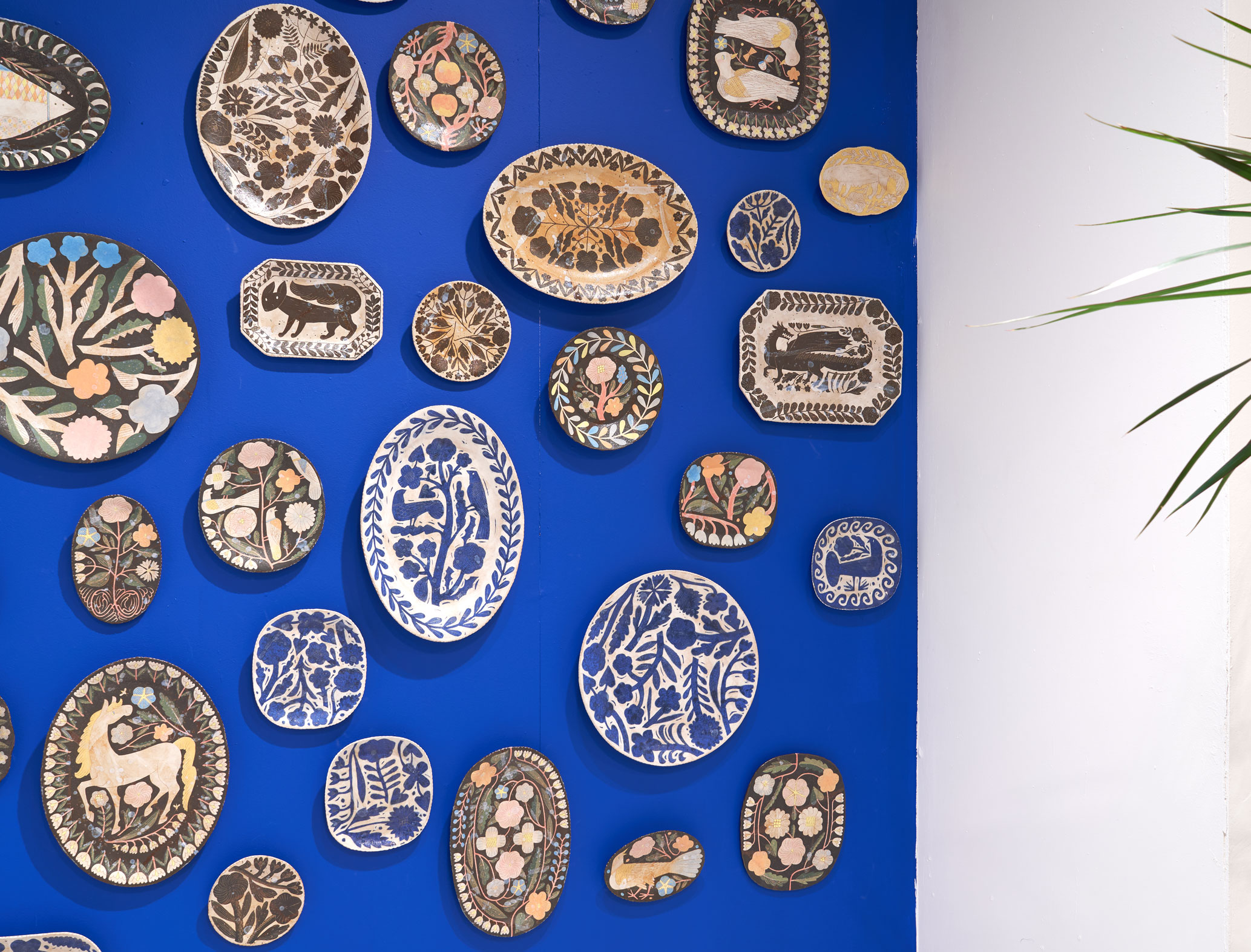
On view at our Wiltshire gallery within the restored Woolland Studio of Elisabeth Frink, a unique collection of works by Japan’s most celebrated ceramicist will be exhibited including a unique response to the drawings of Britain’s groundbreaking female sculptor.
Makoto Kagoshima, based in Kyushu, the southern island of Japan, illustrates whimsical and heart-warming motifs on clay, making each ceramic object a unique, one-of-a-kind piece of art. Kagoshima’s designs are all done freehand. Forms are drawn in pencil on the dried clay then blocks of colour are applied using a paintbrush. Fine lines are then scratched out to give detail, using the improvised tool of a dentist’s pick and the broken rib of an umbrella.
Makoto Kagoshima trained as an artist, and then worked for the Conran Shop in Japan, but it is with clay that he has found his medium. On carved and moulded terracotta bodies, whether plates, vases, tiles or simply designed, three dimensional animals, Kagoshima unfolds a joyful and dreamlike universe of curling tendrils, bursting blooms, charming animals, darting fish, soaring birds, strutting geese and alluring snakes. These highly stylised creatures and plants, some drawn from childhood memory, some swimming up from his dreams, may seem naive, but the designs are sophisticated, the colour sense refined and the craftsmanship accomplished. While each piece is unique, the design language is consistent, creating en masse a distinctive, exuberant imaginary world. Although he first began to work with clay as a child, in his grandfather’s workshop, it was not until he was thirty five that Kagoshima was able to devote himself full time to his ceramics. Since then, his bold, quirky designs have proven so appealing that they have been used also for textiles, prints and murals.
Kagoshima is not the first ceramic artist whose primary gift is draughtsmanship. At a party in Tokyo, in 1909, British artist Bernard Leach, who was to become so influential in the history of British ceramics, was invited to decorate a recently fired piece of raku ware. Entranced by the medium, he later wrote, “By this to me a miracle, I was carried away to a new world.” Leach brought his painting and etching skills to clay, honouring and enhancing the material. He also acted as a primary conduit in the early twentieth century between the ceramic traditions of the East and those of the West, diving back into British traditions of decorative ware from the seventeenth century, as well as the work of William Morris.
Kagoshima’s ceramics also carry us to a new world. And they too link the artistic traditions of East and West. Kagoshima says, “I believe that there is no real difference in ceramic techniques from all over the world. I am influenced by Japanese traditions, from the very old Jamon pottery all the way through to modern ceramics using the latest technologies.” Kagoshima draws his whimsical designs freehand in pencil on dried clay, before applying blocks of colour with a paintbrush, using a wax-resist glazing method. He then scrapes off some of the slip or glaze, with the kaki-otoshi decorative technique, using a wide array of tools to etch his designs: “I use dentist’s tools, broken “bones” from umbrellas, seashells and so on, but basically I use everyday items that are either at hand or that I come across,” he says. The number of firings depends upon the complexity of the design and the techniques used. As for his delightful imagery, again Kagoshima draws on an eclectic array of sources. He says, “From a young age I loved looking at the patterns in my grandmother’s and mother’s kimono collections.” But he also pored over picture books in his school library of everything from the architecture and sculpture of Ancient Greece, the rustic crafts of Spain and Portugal and ancient Mayan, Incan and Aztec imagery, to the Arts and Crafts movement in the United Kingdom, and Scandinavian design. Kagoshima has also explained “my biggest influence is probably from the Romanesque art world, and in particular the craftsmen (not the “famous” artists) of the era, with their fantastic wood or stone-based creations. Fantastic creatures really piqued my interest.” It is this breadth and depth of influence that accounts for the universal appeal of Kagoshima’s pottery: we can all of us respond to his bold vision.
Emma Crichton-Miller is a freelance journalist and TV producer specialising in the arts. She is a columnist for Apollo magazine and is also a freelance contributor to the Royal Academy of Arts